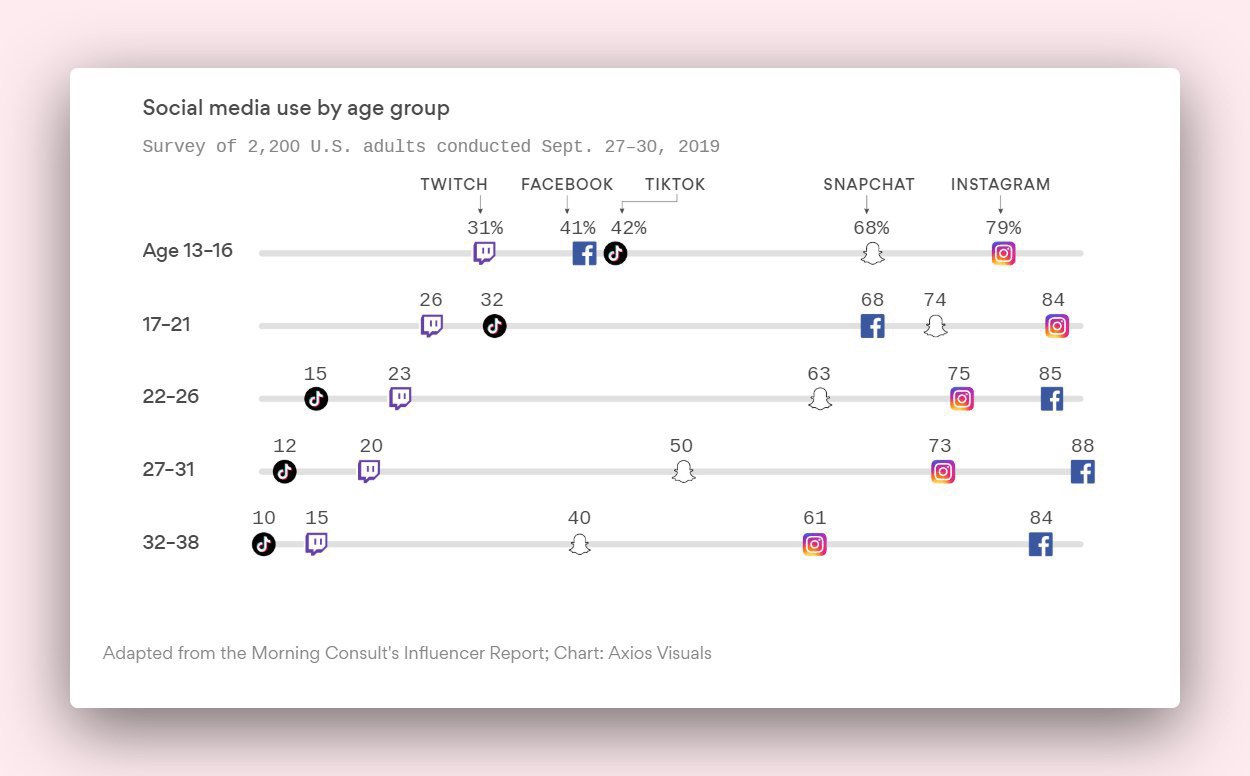Today, social media platforms are an important part of your overall marketing strategy. More than ever, brands are using social media to connect with their audience and promote their product. Using SMM to effectively promote your business and reach your target audience has become a crucial part of successful digital marketing strategies.
Check out our tips below to choose the right social media platform for your business and learn how to create a killer SMM strategy.
What is SMM
SMM stands for Social Media Marketing and just like it sounds, this is a way to promote products and services through social media platforms like Facebook, Instagram, Snapchat, Tiktok, Twitter and so on.
According to Statista, users spend 135 minutes daily on social media in 2019. Compare this with only 90 minutes spent on social media back in 2012. This means that it is worth a shot to use SMM to promote your business.
Daily time spent on social networking in minutes Source: Broadband Search
Source: Broadband Search
Since the rate of social media use is continuing to grow, neglecting promotion through social media means you’re leaving serious money on the table. Let’s figure out why you should register your brand on social media right now.
Benefits of an SMM strategy
Here’s a list of the advantages social media marketing can bring to your digital marketing strategy.
- Increased brand recognition — by creating social media profiles, you expose your brand to communication and engagement with wider audiences and establish your brand as one ready to maintain a dialogue with your audience.
- More inbound traffic — without using SMM to promote your business, you risk limiting your popularity within your circle of existing customers. By exploring various social media platforms, you get to interact with a larger audience and potentially drive more traffic to your site.
- Higher conversion rates — social media platforms are a way to deliver your offers to sites your potential customers already use, this will allow you to receive more orders and purchases.
- Better customer satisfaction — SMM is an opportunity to keep up with the customers’ opinions, mentions on the web, react to the negative ones, and manage your reputation.
How to create an SMM strategy
In case you’re curious about how to create your own social media marketing strategy, here’s a list of steps you can take to nail your SMM.
While creating a SMM strategy, the first thing to do is to sort out why you’re going social at all: remember to align your social media goals with the overall goals of your business to achieve the best results.
| Business goal |
Social media goals |
Metrics |
| Grow your brand |
Determine your perspective audience |
Shares, comments, likes, saves, page views, page likes, page followers |
| Increase customer engagement |
See how your audience is interacting with your existing content |
Engagements, page reach, post reach, likes, comments, mentions |
| Drive conversions |
Understand the effectiveness of your SMM |
Website clicks, signups, purchases, video views |
| Improve customer retention |
Learn what your customers think about your products, services, and brand in general |
Recommendations, feedback about you on social media, shares |
2. Analyze the target audience of your brand
Along with defining the precise goals of your business, you need to define the exact audience that you’re targeting (i.e. your target audience). It’s your audience that’s going to drive business, so you should come up with offers for people who are interested in your perks. Define the customer persona of your target audience. The following data will help you create a customer profile for your audience.
- Geographic location — this way you’ll be able to announce events in relevant areas and promote stores that are close to your audience.
- Age — you’ll be able to distribute offers based on your followers’ age, fulfill their requests, and be relevant to their interests.
- Income — this point is crucial when determining your pricing.
Another cool idea is to get to know the target audience of your competitors. Analyze their activity, which competitors’ content gets the most positive reactions, or leaves the audience indifferent.
Once you determine your target audience and decide on the content you’re about to post, it’s time to choose the right social media platform. However, not each and every social media platform may suit your brand.
Here are some characteristics of the most popular social media platforms to help you choose the right content for the right platform.
- Facebook — comfortable to deliver both news and entertainment and brings more referral traffic than any other social media platform.
- Instagram — suited to spread strong visual content like images and short videos.
- Twitter — can be used to distribute news and share blog updates or website content.
- LinkedIn — a professionally inclined social network, so keep the purely entertaining content away.
- YouTube — is the world’s largest video aggregator, so it’s perfect for spreading video content.
The graph below shows how various social media platforms are allocated according the the audience’s age.
 Social media use by age group. Source: Axios
Social media use by age group. Source: Axios
4. Choose your brand’s tone of voice
The way you address your potential customers is important. The copywriting you choose for your website, emails, and social media influence how your audience perceives your business. Choose how you want your brand’s writing to appear on social media: as if you are talking to your old buddy or your school principal, using an emoji or not, sending short posts or serious longreads, and make sure to stick to these rules in all your posts. You can even put your brand’s name on the links you create and share on social media with Rebrandly URL Shortener. Having a consistent tone helps your brand stay on message.
While engineering your tone of voice, make sure you work on these three essential steps:
- Study your audience — take a look at how your followers communicate with your brand and how they communicate with each other on your social media pages.
- Shape your values — evaluate the main values of your brand to create a culture and community around it.
- Study your competitors — analyze how your competitors interact with their followers to construct the tone of voice and make you stand out from the rest of the companies in your space.
For example, Chubbies, have implemented a distinct and outstanding tone of voice in their SMM. The company prefers to communicate with its followers in a light and humorous way. In their email and social media messages the brand treats users like good friends rather than customers.
Manufacturing predominantly casual clothes with easy-going prints, Chubbies target people who lead an active and sporty lifestyle. Moreover, the company prefers to choose their models from ordinary people rather than model agencies, this way they are winning their audience’s trust and the love of their fan base.
 Example of Chubbies’ tone of voice on Instagram
Example of Chubbies’ tone of voice on Instagram
5. Create an SMM content plan
When you are creating your content plan, you want to separate content into at least three groups: a group for promotional content, one for entertaining content, and another for informative content. Decide on the time and frequency of your posts. Remember to include the following points:
- Choose the important dates. Think of holidays worth your followers’ attention, like we did with the email marketing calendar.
- Elaborate the posting schedule. Make sure your content comes out consistently so that your followers engage with and expect your new posts.
- Create the most suitable content mix. This way you’ll protect your brand from becoming boring. Stick to an 80/20 content ratio: 80% helpful and entertaining content and 20% promotional content.
- Make different content for each platform. Write unique captions for different platforms to avoid copy pasting your posts across platforms.
6. Define KPIs to rate your success
Go back to the basics and reflect on the goals of your social media marketing. Not only will your business goals direct your marketing, but they will also help you decide on KPIs to control the success of your SMM business.
Rate user engagement in your social media activity and see whether this engagement aligns with your primary goals. Count likes, comments, reposts or reshares tounderstand how users interact with your page.
For example, Facebook, allows you to see the number of page views and new page followers within a specific time period.
 Viewing the statistics of the brand’s Facebook page
Viewing the statistics of the brand’s Facebook page
Wrapping up
SMM is a powerful tool to make your brand the talk of the marketing universe. Stick to the following routine when creating your SMM strategy:
- Think of your goals for the direction your business.
- Determine your target audience to understand who you’ll be marketing to.
- Choose the right social media platform to help grow your business.
- Create a unique tone of voice to stand out among your competitors.
- Create a social media content plan, and be sure to vary the type of content you post.
- Analyze your results to track the success of your SMM efforts.
Don’t forget to use SendPulse to help you promote your social media pages through email campaigns. We are ready to help you create the perfect email campaign to start growing your social media presence and kick-start your SMM. Good luck :).